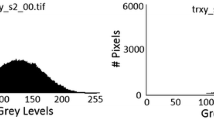Abstract
This paper presents a study, based on conic correspondences, on the relationship between two perspective images acquired by an uncalibrated camera. We show that for a pair of corresponding conics, the parameters representing the conics satisfy a linear constraint. To be more specific, the parameters that represent a conic in one image are transformed by a five-dimensional projective transformation to the parameters that represent the corresponding conic in another image. We also show that this transformation is expressed as the symmetric component of the tensor product of the transformation based on point/line correspondences and itself. In addition, we present a linear algorithm for uniquely determining the corresponding point-based transformation from a given conic-based transformation up to a scale factor. Accordingly, conic correspondences enable us to easily handle both points and lines in uncalibrated images of a planar object.
Similar content being viewed by others
References
F. Chatelin, Valeurs propres de matrices, Masson: Paris, 1988. (W. Ledermann (trans.), Eigenvalues of Matrices, John-Wiley and Sons, Chichester, 1993.)
H.S.M. Coxeter, Projective Geometry, 2nd edn., Springer-Verlag: New York, U.S.A., 1987.
O. Faugeras and B. Mourrain, “On the geometry and algebra of the points and lines correspondences between N images,” in Proc. of the 5th ICCV, 1995, pp. 951–956.
O.D. Faugeras and L. Robert, “What can two images tell us about a third one?,” Int. J. of Computer Vision, Vol. 18, No. 1, pp. 5–19, 1996.
G.H. Golub and C.F. van Loan, Matrix Computation, 2nd edn., Johns Hopkins Univ. Press, 1989.
R. Hartley, “Lines and points in three views-An integrated approach,” in Proc. of ARPA Image Understanding Workshop, 1994, pp. 1009–1016.
R. Hartley, “A linear method for reconstruction from lines and points,” in Proc. of the 5th ICCV, 1995, pp. 882–887.
R. Hartley, “Lines and points in three views and the trifocal tensor,” Int. J. of Computer Vison, Vol. 22, No. 2, pp. 125–140, 1997.
R. Hartley, “Computation of the quadrifocal tensor,” in Proc. of the 5th ECCV, Vol. 1, 1998, pp. 20–35.
A. Heyden, “A common framework for multiple view tensors,” in Proc. of the 5th ECCV, Vol. 1, 1998, pp. 3–19.
A. Heyden, “Reduced multilinear constraints: Theory and experiments,” Int. J. of Computer Vision, Vol. 30, No. 1, pp. 5–26, 1998.
S.D. Ma, “Conics-based stereo, motion estimation, and pose determination,” Int. J. of Computer Vision, Vol. 10 No. 1, pp. 7–25, 1993.
S.D. Ma, S.H. Si, and Z.Y. Chen, “Quadric curve based stereo,” in Proc. of the 11th ICPR, Vol. 1, 1992, pp. 1–4.
L. Quan, “Invariant of a pair of non-coplanar conics in space: Definition, geometric interpretation and computation,” in Proc. of the 5th ICCV, 1995, pp. 926–931.
L. Quan, “Conic reconstruction and correspondence from two views,” IEEE Trans. on PAMI, Vol. 18, No. 2, pp. 151–160, 1996.
C. Schmid and A. Zisserman, “The geometry and matching of curves in multiple views,” in Proc. of the 5th ECCV, Vol. 1, 1998, pp. 394–409.
J.A. Schouten, Tensor Analysis for Physicists, 2nd edn., Dover: New York, U.S.A., 1989.
J.G. Semple and G.T. Kneebone, Algebraic Projective Geometry, Clarendon Press: Oxford, U.K., 1952 (reprinted in 1979).
A. Shashua, “Trilinearity in visual recognition by alignment,” in Proc. of the 3rd ECCV, Vol. 1, 1994, pp. 479–484.
A. Shashua, “Algebraic functions for recognition,” IEEE Trans. on PAMI, Vol. 17, No. 8, pp. 779–789, 1995.
A. Shashua and M. Werman, “Trilinearity of three perspective views and its associated tensor,” in Proc. of the 5th ICCV, 1995, pp. 920–925.
A. Sugimoto, “Conic based image transfer for 2-D objects: A linear algorithm,” in Proc. of the 3rd ACCV, Vol. II, 1998, pp. 161–168.
A. Sugimoto and T. Matsuyama, “Multilinear relationships between the coordinates of corresponding image conics,” in Proc. of the 15th ICPR, 2000.
B. Triggs, “Matching constraints and the joint image,” in Proc. of the 5th ICCV, 1995, pp. 338–343.
R.Y. Tsai and T.S. Huang, “Uniqueness and estimation of three dimensional motions parameters of rigid objects with curved surfaces,” IEEE Trans. on PAMI, Vol. 6, No. 1, pp. 13–27, 1984.
I. Weiss, “3D curve reconstruction from uncalibrated cameras,” Technical Report, CSTR-TR-3605, Computer Vision Laboratory, Center for Automation Research, University of Maryland, 1996.
I. Weiss, “3-D curve reconstruction from uncalibrated cameras,” in Proc. of ICPR, Vol. 1, 1996, pp. 323–327.
Z. Zhang, “Parameter estimation techniques: A tutorial with application to conic fitting,” Image and Vision Computing, Vol. 15, No. 1, pp. 59–76, 1997.
Author information
Authors and Affiliations
Rights and permissions
About this article
Cite this article
Sugimoto, A. A Linear Algorithm for Computing the Homography from Conics in Correspondence. Journal of Mathematical Imaging and Vision 13, 115–130 (2000). https://doi.org/10.1023/A:1026571913893
Issue Date:
DOI: https://doi.org/10.1023/A:1026571913893




